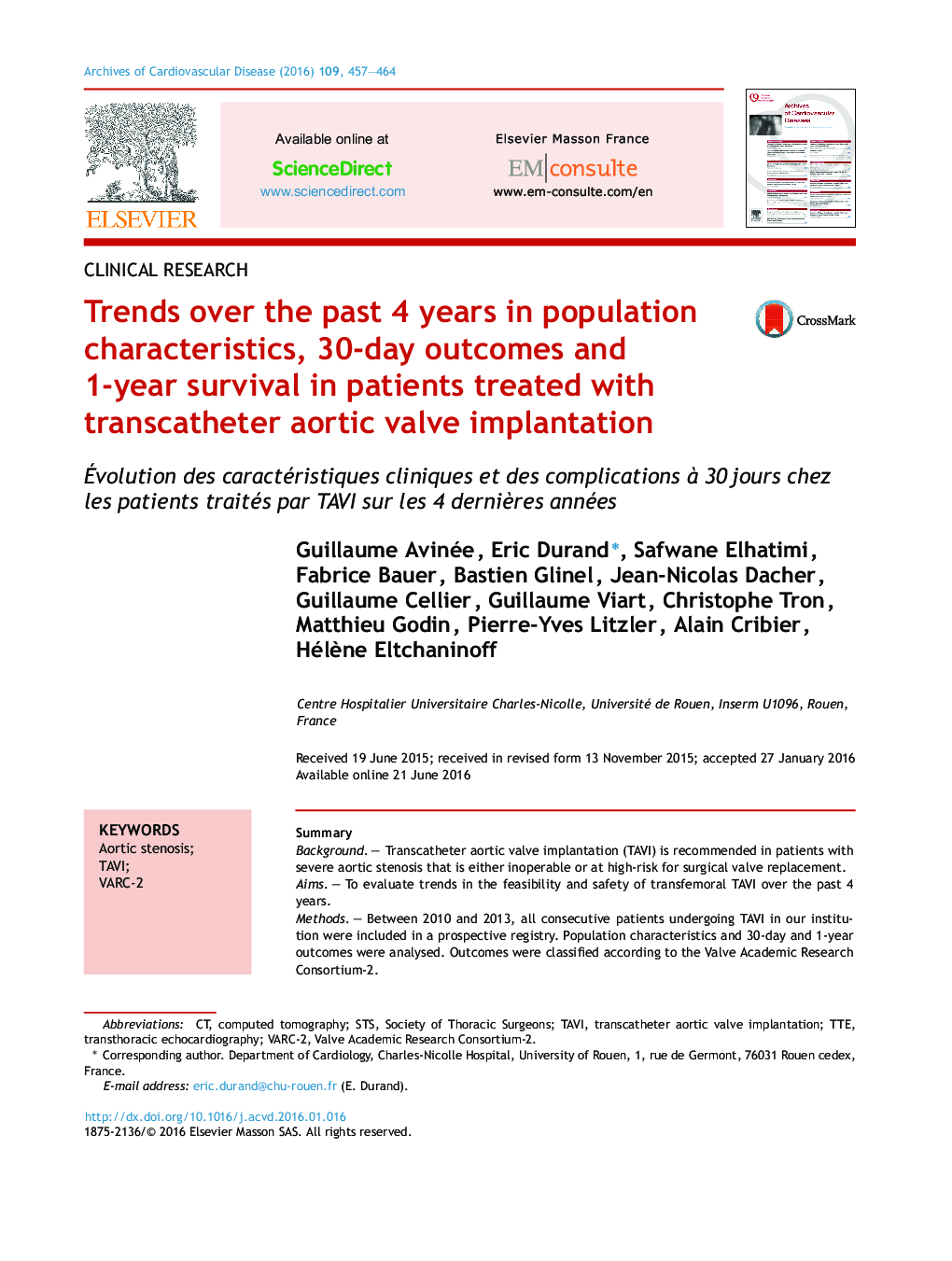| کد مقاله | کد نشریه | سال انتشار | مقاله انگلیسی | نسخه تمام متن |
|---|---|---|---|---|
| 2888602 | 1574332 | 2016 | 8 صفحه PDF | دانلود رایگان |

SummaryBackgroundTranscatheter aortic valve implantation (TAVI) is recommended in patients with severe aortic stenosis that is either inoperable or at high-risk for surgical valve replacement.AimsTo evaluate trends in the feasibility and safety of transfemoral TAVI over the past 4 years.MethodsBetween 2010 and 2013, all consecutive patients undergoing TAVI in our institution were included in a prospective registry. Population characteristics and 30-day and 1-year outcomes were analysed. Outcomes were classified according to the Valve Academic Research Consortium-2.ResultsOverall, 429 patients underwent TAVI; transfemoral access was used in 368 (85.7%). The proportion of patients treated via a transfemoral approach increased (70.1% to 89.9%; P < 0.0001) and the use of prior balloon aortic valvuloplasty decreased (44.7% to 11.2%; P < 0.0001). The mean logistic EuroSCORE decreased significantly from 19.4 ± 10.9% to 15.8 ± 8.7% (P = 0.01). The 30-day mortality rate did not change significantly (6.4% vs. 5.6%; P = 0.99). Similarly, rates of major vascular complications (12.8% vs. 15.4%; P = 0.87) and stroke (2.1% vs. 1.4%; P = 0.75) remained unchanged. Mean length of stay after TAVI decreased significantly from 8.9 ± 11.3 days to 4.8 ± 4.7 days (P = 0.002) and 72 (50.3%) patients were discharged early in 2013. One-year survival increased significantly from 81.0% to 94.4% (P = 0.03).ConclusionsOver the past 4 years, TAVI has been increasingly performed using a transfemoral approach. Treated patients are at lower-risk with less co-morbidity. Thirty-day mortality and complications remained unchanged, but length of stay after TAVI and 1-year mortality decreased dramatically.
RésuméContexteL’implantation d’une valve aortique par voie percutanée est actuellement indiquée chez les patients présentant un rétrécissement aortique serré et symptomatique quand ils sont jugés inopérables ou à haut risqué chirurgical.ObjectifÉvaluation de la faisabilité et de la sécurité d’une implantation d’une valve aortique par voie percutanée (TAVI) sur une période de 4 ans.MéthodesDe 2010 à 2013, les patients bénéficiant d’un TAVI dans notre centre ont été inclus consécutivement dans un registre prospectif. Les caractéristiques de la population, les résultats à 30 jours et la survie à un an ont été analysés. Les évènements ont été classés selon les critères établis pas le Valve Academic Research Consortium (VARC)-2.RésultatsQuatre cent vingt-neuf patients ont bénéficié d’un TAVI, par accès transfémoral (TF) dans 368 cas (85,7 %). La proportion de voie TF a augmenté de 70,1 % à 89,9 % (p < 0,0001) et le recours préalable à une valvuloplastie au ballon a diminué de 44,7 % à 11,2 % (p < 0,0001). L’EuroSCORE logistique moyen a diminué de 19,4 ± 10,9 % à 15,8 ± 8,7 % (p = 0,01). La mortalité à 30 jours ne changeait pas significativement (6,4 % contre 5,6 % ; p = 0,99). Les complications vasculaires majeures (12,8 % contre 15,4 % ; p = 0,87) et les accidents vasculaires cérébraux (2,1 % contre 1,4 % ; p = 0,75) présentaient une incidence stable. La durée moyenne de séjour a diminué de 8,9 ± 11,3 à 4,8 ± 4,7 jours (p = 0,002) et 72 (50,3 %) patients bénéficiaient d’un retour précoce à domicile. La survie à 1 an s’est améliorée significativement (p = 0,03).ConclusionsLe TAVI a été pratiqué de manière croissante, l’approche transfémorale ayant été possible chez 90 %. Les patients sont à moindre risque. La mortalité à 30 jours et les complications restent inchangées alors qu’on note une importante diminution de la durée de séjour et une amélioration de la survie à 1 an.
Journal: Archives of Cardiovascular Diseases - Volume 109, Issues 8–9, August–September 2016, Pages 457–464